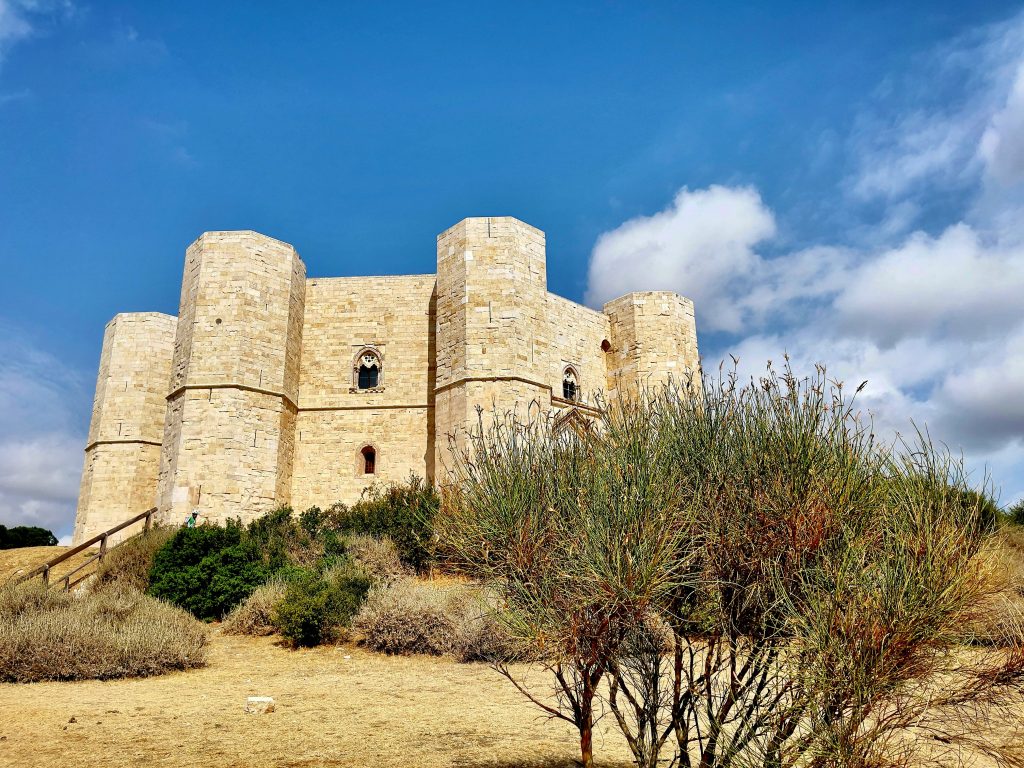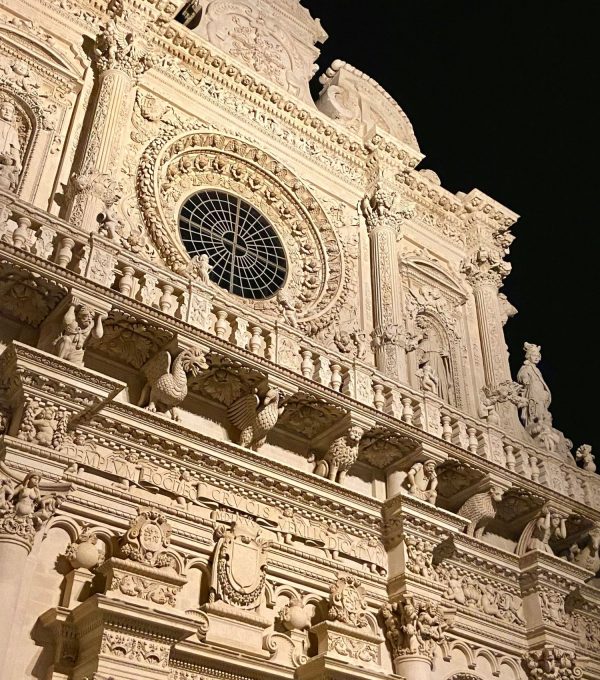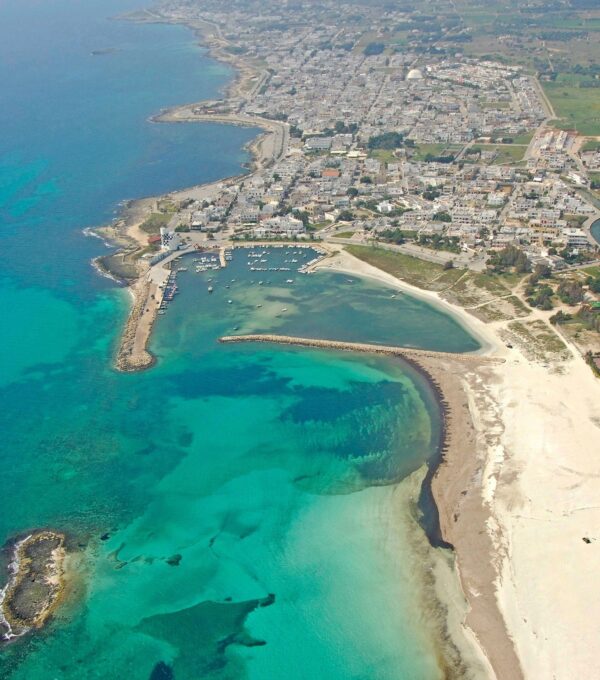In the heart of Puglia, stands an architectural jewel that fascinates and enchants visitors for centuries: Castel del Monte.
The fortress is located in the territory of the Alta Murgia National Park.
These two iconic places offer an extraordinary experience, combining the millennial history of medieval architecture with the unspoilt beauty of nature.
Castel del Monte, short history
Located on a hill 500 meters high, isolated in the Apulian countryside in the municipality of Andria, province of Barletta-Andria-Trani (BAT), Castel del Monte rises as a monolith of absolute beauty and mystery. This castle is an extraordinary example of medieval architecture, with its unique octagonal shape and its perfect symmetry. Built in the 12th century by order of Frederick II of Swabia, Castel del Monte presents a unique combination of Norman, Gothic and Oriental architectural elements, reflecting the eclectic genius of its patron.
Frederick II of Swabia, a figure shrouded in mystery and surrounded by legends, was one of the most fascinating characters of the Middle Ages. Passionate about mathematics, poetry, philosophy, astronomy and falconry, this cosmopolitan ruler has left an indelible mark on history, welcoming scholars from different cultures to his royal court in Palermo.
During his reign, Frederick II built many castles in southern Italy, but it is in Castel del Monte that emerge his unique vision and his passions.
It has been built with extreme geometric and mathematical rigor since 1240, combining different stylistic elements in a perfect mix that leaves today’s tourists amazed.
Among the first written testimonies on the construction of the building, the letter itself of Emperor Frederick II of 29 January 1240, who ordered the construction of a castle at the church and monastery of Santa Maria del Monte. The Bull Dignitatem ecclesiis, a privilege of Pope Callistus II of 6 November 1120, documents the existence of the monastery, destroyed in 1317. The architect’s attribution is uncertain, although many historians tend to direct the Emperor’s involvement in the architectural project.
The castle was used as a prison during the reign of Manfred and Charles I, and suffered damage during a French expedition in 1528. In 1552 it was sold to the Count of Ruvo and then bought by the Italian State in 1876. Restored over time, in 1996 it was included in the list of UNESCO World Heritage Sites.
Architectural style of the castle
The castle has an octagonal shape and has a perfect symmetry in all its parts. The exterior walls are made of local limestone blocks, which give the castle a robust and imposing appearance. The size of Castel del Monte is remarkable. The plan of the castle is a regular octagon, each side measuring 16.30 meters.
Inside there is another octagon, the courtyard, whose sides measure 8.65 meters each.
The original height of the courtyard wall was 20.50 meters, while the diameter of the courtyard is 17.87 meters.
On the edges of the octagonal plan are placed eight octagonal towers whose faces measure each 3.10 meters. The diameter of the castle is 56 meters, while the diameter of each tower is 7.80 meters.
The length of each curtain wall between the towers is 10.30 meters, while the thickness of the walls of the external curtains is 2.40 meters.
The height of each tower is 24 meters.
Access to the castle is through a single entrance, surmounted by a round arch. The entrance door is protected by two stone lions, which add a touch of grandeur to the castle entrance.
Inside, the Castel del Monte is characterized by a central courtyard, surrounded by a series of rooms on two floors.
The rooms are eight on the ground floor and eight on the first floor, the geometry of the number eight repeated obsessively in the building, have led scholars to think of an esoteric meaning of the castle.
For example, the domes of churches and ancient and medieval buildings often have an octagonal shape, evoking the starry sky. The octagon, similar to the circle, represents the idea of eternity, while the number eight is considered sacred, symbol of resurrection and attribute of Mary.
This deep symbolism has ancient roots: among its illustrious lovers there are Plutarch, Saint Ambrose and Saint Augustine of Hippo. The choice of the octagon for the domes or for the plan of a building is not accidental, but reflects the richness of meaning and the sacredness attributed to these architectural structures.
Through the symbolism of number eight, ancient and medieval buildings celebrate spirituality and the search for eternity, offering a tangible reminder to the divine through art and architecture.
The interior of the castle is now stripped of furnishings and architectural friezes, only medieval fireplaces remain.
The light that illuminates the first floor comes from eight single-lancet windows located on each of the eight sides of the plant. The same number of windows is located on the upper floor, with a small difference: seven windows are mullioned windows, while one, facing Andria, divided into three openings.
The two floors of the fortress are connected internally by spiral staircases located only in three octagonal towers.
What makes Castel del Monte truly extraordinary, moreover, is its carefully studied position, which gives spectacular effects of light and shade during specific periods of the year. It is a place steeped in history, culture and beauty, which enchants tourists with its magnificence and timeless charm.

Foto : Unsplash
Useful information to visit Castel del Monte
The castle can be visited, there is an entrance fee and its opening hours are as follows:
- Open every day, except December 25 and January 1;
- 1 April to 30 September from 10 to 18.45.
Last admission allowed at 18;
- October 1 to March 31 from 9 am to 5.45 pm.
Last admission allowed at 17.
How to reach Castel del Monte
By car: from Bari, take the SP231 to the exit Minervino /Castel del Monte and then the SP234. From Andria you can reach Castel del Monte along the SS170dir.
From the town of Andria you can take an urban bus that guarantees the connection between the city and Castel del Monte.
By train: Andria has a railway station connected with all the cities of Puglia, once you arrive in Andria, continue to Castel del Monte using the urban bus service.
The National Park of Alta Murgia
The National Park of Alta Murgia, established with d.p.r. March 10, 2004, is among the largest in Italy with its 68,077 hectares, included in the territories of the thirteen municipalities of the Park: Altamura, Andria, Bitonto, Cassano Murge, Corato, Gravina in Puglia, Grumo Appula, Minervino Murge, Poggiorsini, Ruvo di Puglia, Santeramo in Colle, Spinazzola, Toritto.
These municipalities are part of the Provinces of Bari and BAT.
The Park is characterized by the presence of two priority habitats: the “Prairies on calcareous substrate with wonderful flowering of orchids” and the “Substeppic paths of grasses and annual plants”. The Park is characterized by a spectacular variety of natural elements, including rocky ridges, sinkholes, rolling hills, karst cavities and steep escarpments. Here the action of nature and that of man are mixed through centuries of history. Stone farms, sometimes fortified, testify to the human presence, with fences, stables, cisterns and churches.
The Alta Murgia tells the story of man through the landscape, with stories of shepherds, farmers and ancient inhabitants who shared the land with dinosaurs and domestic animals. Numerous tombs dug into the stone and preserved human skeletons testify to this millennial history.
The traces of the Norman-Swabian domination are found in the historic centers of the thirteen municipalities of the Park, culminating in the imposing Castel del Monte. The flora and fauna are other relevant features of the Park.
Flora and fauna of the Park
The Alta Murgia is home to a variety of vegetation, with rock formations, dense forests and extensive grasslands. Among the most common trees are cypress, Aleppo pine and oak, while in the woods there are oaks, frags, thorny oaks and holm oaks. In the steppe areas, the asphodel, the ferula and numerous species of orchids abound, including some native to the territory. The undergrowth is rich in plants such as honeysuckle, hawthorn and myrtle, while capers, rosemary and oregano grow on the rocks. In the pastures, there are asparagus, figs, almonds and other tree and shrub plants. Numerous flowers embellish the landscape, along with edible mushrooms such as cardoncello. In the Park, you can find a variety of mammals, including weasels, martens, porcupines, hares, squirrels, and different types of rodents such as the muscardine, dormouse and wild mouse. The presence of foxes, badgers and polecats add to the diversity of the fauna.
Particularly interesting are the wild cats, while the chiroptera enrich the naturalistic panorama.
In the past, wolves were present in the Park, but their population has decreased. However, with the increase in boars, new sightings of wolves have been recorded returning to the area. These animals are adapting to the habitat of the Murgia, with reports of presence in the areas of the provinces of Brindisi and Taranto.
Among the reptiles, there are the lizard, the gecko of Kotschy and several snakes, including the viper, the deer, the white-tailed snake, the collared snake and the leopard grouse.
Despite the arid environment, there are amphibians such as the common toad, the emerald toad, the Uzzell frog, the Apennine howl and the Italian newt.
The park is home to many species of birds, including the curlew eye and the white ass, while a project is underway to reintroduce the prairie hen. They are common thrushes, blackbirds, hoopoes, nightingales, robins, ravens, jackdaws and magpies. You can also spot red and green woodpeckers, wild doves, wild doves and collared doves. Among the birds of prey are the kestrel, the black kite, the woolly falcon, the peregrine falcon, the cricket falcon, the golden eagle, the buzzard, the red kite, the short-toed harrier, the marsh harrier, the barn owl, the owl, the tawny owl and the rattan. Furthermore, it is possible to sight the grey heron and the stork during the migration periods.
In the Park you can also admire the ancient remains of the past, including historic sacred buildings and castles.
On the official website of the Alta Murgia National Park, tourists and hikers can download a free guide with all the information to visit the park safely.
The Flavours of the Park
The cuisine of Alta Murgia offers typical dishes that combine local spontaneous essences such as chicory, fennel, lampascione and cardoncello mushroom with agricultural products such as durum wheat semolina. Local farms produce cheeses such as canestrato pugliese, “fior di latte” and “ricotta forte”, as well as lamb, kid and sheep meat dishes. In some areas there are horse meat dishes. The local olive oil, produced in the foothills, has obtained the recognition of the D.O.P. “Land of Bari-Bitonto”. Among the local wines, we mention the D.O.C. “Gravina”, “Gioia del Colle”, “Castel del Monte” and others with the I.G.T. “Murge” brand.
How to reach the Park
By car: from the A14 motorway Bologna – Bari, exit at Trani, Molfetta, Bitonto, Bari-Nord, Bari-Sud and Gioia del Colle, then follow the directions to the cities of Murgia. From Basilicata and Calabria is accessed via the state roads 96, 97 and 99.
By train: with the Ferrovie Apulo Lucane (FAL) you can reach Gravina in Puglia, passing through various towns of Murgia. With the State Railways (Trenitalia), you can get to Gioia del Colle and from there proceed towards Santeramo, Altamura, Gravina, Poggiorsini, Spinazzola or Minervino Murge. The Ferrovie Bari-Nord (Ferrotramviaria spa) connects Bitonto, Ruvo, Corato and Andria.
By plane: from Palese Airport you reach Bari and then continue towards Altamura or Gravina in Puglia with the trains of the Ferrovie Apulo Lucane (FAL).
Copertina: Unsplash



